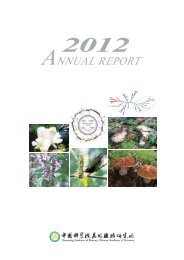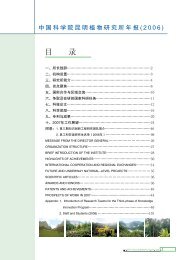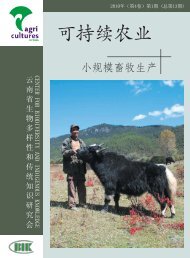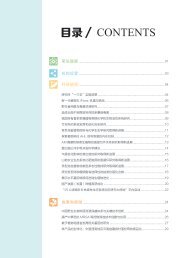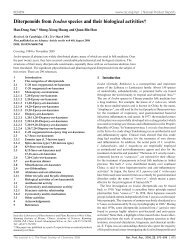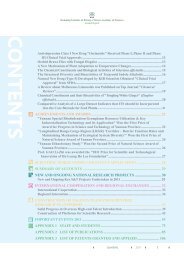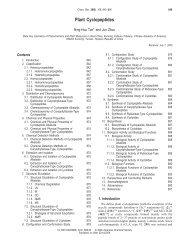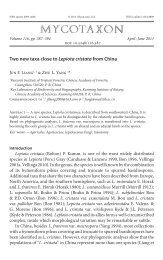Ligularia qiaojiaensis sp. nov. (Asteraceae) from Yunnan, China
Ligularia qiaojiaensis sp. nov. (Asteraceae) from Yunnan, China
Ligularia qiaojiaensis sp. nov. (Asteraceae) from Yunnan, China
Create successful ePaper yourself
Turn your PDF publications into a flip-book with our unique Google optimized e-Paper software.
<strong>Ligularia</strong> <strong>qiaojiaensis</strong> <strong>sp</strong>. <strong>nov</strong>. (<strong>Asteraceae</strong>) <strong>from</strong> <strong>Yunnan</strong>, <strong>China</strong><br />
Hong-Jin Dong and You-Sheng Chen<br />
H.-J. Dong, Kunming Inst. of Botany, Chinese Academy of Sciences, CN 650204 Kunming, PR <strong>China</strong>. HJD also at: Graduate Univ. of<br />
Chinese Academy of Sciences, CN 100049 Beijing, PR <strong>China</strong>. Y.-S. Chen (maple@ibcas.ac.cn), Inst. of Botany, Chinese Academy of Sciences,<br />
CN 100093 Beijing, PR <strong>China</strong>.<br />
<strong>Ligularia</strong> <strong>qiaojiaensis</strong> Y. S. Chen & H. J. Dong <strong>sp</strong>. <strong>nov</strong>., known <strong>from</strong> two localities in northeastern <strong>Yunnan</strong> province of<br />
<strong>China</strong>, is described, illustrated and compared with similar <strong>sp</strong>ecies.<br />
<strong>Ligularia</strong> Cassini (<strong>Asteraceae</strong>) is a genus with more than<br />
125 <strong>sp</strong>ecies distributed in Asia and Europe (Nordenstam<br />
2007). Liu (1989) recorded 111 <strong>sp</strong>ecies of <strong>Ligularia</strong> in<br />
<strong>China</strong>.<br />
In 2007, during an examination of <strong>Asteraceae</strong> <strong>sp</strong>ecimens<br />
collected by H. Wang <strong>from</strong> Yaoshan mountain, Qiaojia<br />
county, <strong>Yunnan</strong> province, <strong>China</strong>, the second author found<br />
a strange <strong>Ligularia</strong> <strong>sp</strong>ecimen with pinnately dissected leaves,<br />
resembling L. przewalskii Maxim. but differing by much<br />
shorter inflorescence and larger capitula. In July 2009, the<br />
second author made an expedition to Yaoshan mountain<br />
and collected the same kind of <strong>sp</strong>ecimens, confirming that<br />
it is really a new <strong>sp</strong>ecies. Roughly at the same time, in 2008,<br />
the same kind of <strong>sp</strong>ecimens were collected by Dr H. Peng<br />
<strong>from</strong> Jiaozi mountain, Dongchuan county, <strong>Yunnan</strong> province,<br />
about 117 km directly south of the Yaoshan<br />
mountain.<br />
<strong>Ligularia</strong> <strong>qiaojiaensis</strong> Y. S. Chen & H. J. Dong <strong>sp</strong>. <strong>nov</strong>.<br />
(Fig. 1)<br />
Species L. przewalskii affinis, sed capitulis majoribus, phyllariis<br />
8 9, radiis 4 5 differt.<br />
Type: <strong>China</strong>. <strong>Yunnan</strong> province, Qiaojia county, Yaoshan,<br />
Qiaoshan, wet grassy slopes along forest margin, 2734 m<br />
a.s.l., 27813?41ƒN, 10385?25ƒE, 21 Jul 2009, Y. S. Chen<br />
and Z. H. Wang 9033 (holotype: PE, isotype: KUN).<br />
Perennial herb. Roots numerous, stout and fleshy, ca<br />
1.5 mm in diameter. Stems erect, to 70 cm tall, ca 3 mm<br />
in diameter, longitudinally angulate, base surrounded<br />
by withered petiole fibres. Basal leaves petiolate; petiole<br />
12 20 cm, glabrous, base sheathed; leaf blade chartaceous,<br />
cordate-orbicular, pinnately dissected, 7 24 cm long, 8<br />
25 cm wide, adaxially green, covered with <strong>sp</strong>arse white<br />
glandular hairs, abaxially pale green, glabrous; cauline leaves<br />
Nordic Journal of Botany 28: 683 684, 2010<br />
doi: 10.1111/j.1756-1051.2010.00745.x,<br />
# The Authors. Journal compilation # Nordic Journal of Botany 2010<br />
Subject Editor: Henrik Ærenlund Pedersen. Accepted 30 March 2010<br />
3 4, petioles 5 23 cm long, base enlarged sheathing, upper<br />
leaves with smaller blade and shorter petioles. Inflorescence<br />
racemose, to 25 cm long, densely covered with rust-colored<br />
glandular hairs; peduncles 0.3 1.2 ( 8) cm long. Capitula<br />
8 15, supplementary bracts subulate. Involucre green,<br />
turbinate, 8 10 mm in diameter, ca 1 cm high; phyllaries<br />
in 2 series, 8 9, equal in length, broadly oblong, ca 1 cm<br />
long, 2 3 mm wide, apex acute. Ray florets yellow, 4 5,<br />
ligules lanceolate, apex acute and denate, ca 16 18 mm long<br />
and ca 3 mm wide, tube ca 4 mm long; disc florets 16 18,<br />
tube ca 5 mm long, limb ca 5 mm long, campanulate,<br />
5-lobed, lobes lanceolate, ca 2 mm long and ca 0.3 mm<br />
wide. Style ca 12 mm long, stigma brownish yellow,<br />
2-branched, branches reflexed, ca 2 mm long; anther tube<br />
brown, ca 5 mm long. Pappus brown, 4 5 mm long.<br />
Achenes cylindroid, ca 5 mm long, ca 0.6 mm wide, apex<br />
truncate, longitudinally ribbed. Flowering in Jul early Aug.<br />
Distribution, habitat and conservation status<br />
<strong>Ligularia</strong> <strong>qiaojiaensis</strong> is known only <strong>from</strong> two nearby<br />
localities in northeastern <strong>Yunnan</strong> province, <strong>China</strong>, where<br />
it was first collected in 2004. It grows in wet grassy slopes<br />
along forest margin at an altitude of 2700 3350 m a.s.l.<br />
The population size is very small (less than 50) in both<br />
two localities. According to IUCN (2001), it should be<br />
categorized as ‘Endangered’ (EN).<br />
Similar <strong>sp</strong>ecies<br />
<strong>Ligularia</strong> <strong>qiaojiaensis</strong> is most similar to L. przewalskii in its<br />
dissected leaves and racemose inflorescence, but differs by<br />
pinnately dissected leaves, much larger heads, 8 9 phyllaries<br />
and 4 5 ray florets. It is somewhat similar to L. paradoxa<br />
Hand.-Mazz. With re<strong>sp</strong>ect to leaf shape, but differs<br />
by racemose inflorescence and ray florets. The main<br />
morphological differences between the new <strong>sp</strong>ecies and<br />
L. przewalskii are given in Table 1.<br />
683<br />
A SIATIC V ASCULAR P LANT T AXONOMY S PECIAL ISSUE
A SIATIC V ASCULAR P LANT T AXONOMY S PECIAL ISSUE<br />
Figure 1. <strong>Ligularia</strong> <strong>qiaojiaensis</strong> Y. S. Chen & H. J. Dong <strong>sp</strong>. <strong>nov</strong>. (a) habit (lower part), (b) habit (upper part), (c) ray florets, (d) disc<br />
florets, (e) phyllaries.<br />
We found other <strong>Ligularia</strong> <strong>sp</strong>ecies in a nearby locality,<br />
including L. fischeri (Ledeb.) Turcz., L. nelumbifolia<br />
(Bureau et Franch.) Hand.-Mazz. and L. lamarum (Diels)<br />
Chang. However, none of these <strong>sp</strong>ecies has dissected leaves<br />
and similar heads, so L. <strong>qiaojiaensis</strong> can not be a hybrid<br />
between these <strong>sp</strong>ecies.<br />
Table 1. Morphological differences between <strong>Ligularia</strong> <strong>qiaojiaensis</strong><br />
<strong>sp</strong>. <strong>nov</strong>. and L. przewalskii.<br />
Features L. <strong>qiaojiaensis</strong> L. przewalskii<br />
Leaf blade pinnately dissected palmately dissected<br />
Inflorescence length (cm) 10 25 30 60<br />
Capitula 7 15 40 100<br />
Involucre diameter (mm) 8 10 2 3<br />
Phyllaries 8 9 4 6<br />
Ray florets 4 5 2 3<br />
684<br />
Additional <strong>sp</strong>ecimens examined (paratypes)<br />
<strong>China</strong>. <strong>Yunnan</strong> province, Qiaojia county, Yaoshan,<br />
Qiaoshan, 2700 2900 m a.s.l., 5 Jul 2004, H. Wang et al.<br />
03-1233 (KUN); Dongchuan county, Tangdan, Jiaozi<br />
mountain, alpine meadow along streams, 26810?46ƒN,<br />
102857?36ƒE, 3350 m a.s.l., 26 Jul 2008, H. Peng et al.<br />
HP8738 (KUN).<br />
References<br />
IUCN 2001. IUCN red list categories and criteria, ver. 3.1.<br />
IUCN Species Survival Commission.<br />
Liu, S. W. 1989. <strong>Ligularia</strong> Cass. In: Ling, Y. and Liu, S. W.<br />
(eds), Flora Reipubl. Pop. Sin. 77. Science Press, pp. 4 115.<br />
Nordenstam, B. 2007. Tribe Senecioneae. In: Kadereit, J. W.<br />
and Jeffrey, C. (eds), Kubitzki’s the familes and genera of<br />
vascular plants. Vol. 8. Springer, pp. 208 241.



